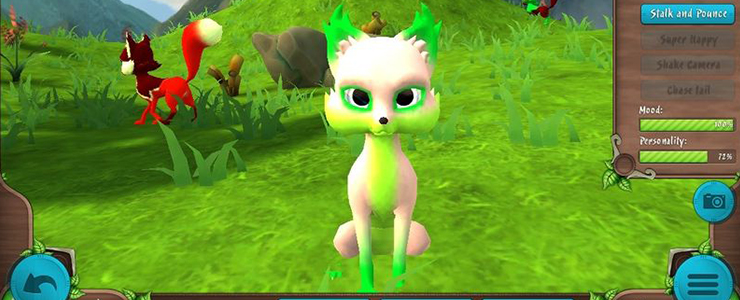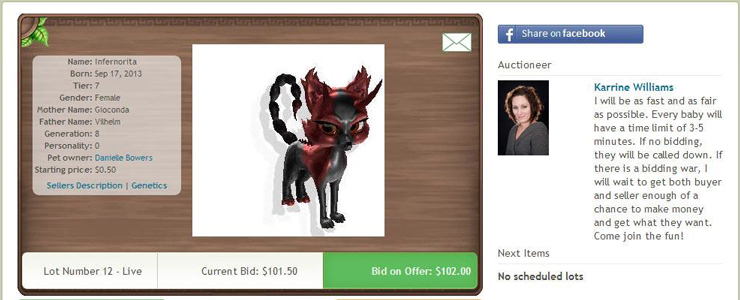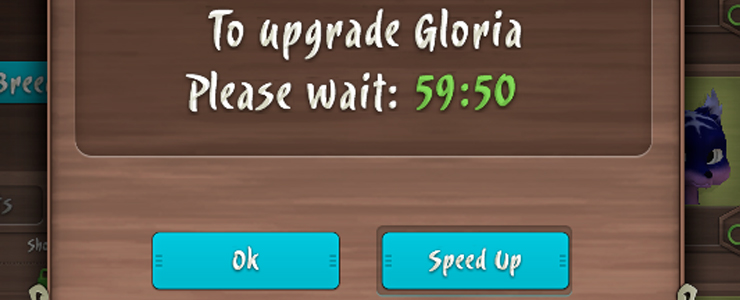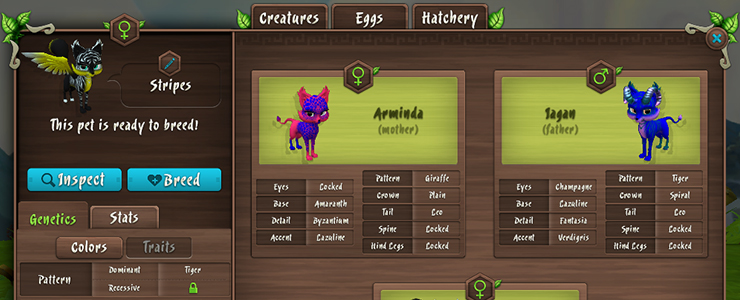· 7 min read
Flying Monkey Interactive on Strangelings
Anamaria Todor
Ana Todor is a Computer Scientist with a playful and literary twist. She has a Bachelor of Science degree in Engineering and a Bachelor of Arts degree in Cultural Studies.
We’ve been snooping around for more game studios that use the GameAnalytics service and we stumbled upon the intriguing Flying Monkey Interactive. Their first game, Strangelings, demonstrates that genetics and games go very well together and has been “blamed” to cleverly mingle the uncontrollable urge of collecting with the irresistibly cute interactivity of a Tamagotchi. It is available for both browsers and iPads. We sat down with the studio’s founders, Ben Rohr (CFO) and Chris Collins (CEO) to find out more about the bliss of furry critters, genetics and how GameAnalytics fits in the mix.
Tell us a bit about your studio.
Ben: Flying Monkey Interactive is one year old and has 5 people distributed throughout the US in New York, San Francisco and Birmingham, Alabama. We also draw on a large pool of freelancers to supplement our development. Our focus is building games that incorporate genetics algorithms into the game play. With our first game, Strangelings, we have built out a game platform that supports these types of games and plan to publish more games in the future.
How was the concept behind Strangelings born ?
Ben: We come from a background of working at Linden Lab (creators of Second Life) and have experience with a similar genetics-based game in Second Life and working with virtual economies. We wanted to take some of the key elements that made the game in Second Life successful and bring it out to the mobile and web platforms.

Thus, genetics gives Strangelings the ability for new content to be created by the user through natural game play. With hundreds of millions of different pet trait combinations available, the more a user breeds, the more unique content is released into the game and economy.
We therefore not only have incorporated genetics into the game, but we have an in game economy where the users can buy and sell animals for real money in our live Auction House. The Auctions are all run by the users, and the seller of the animal takes 75% from the sale (The Auctioneer, who is also a player, gets 10%). These elements are what makes Strangelings unique as a casual game.

We also wanted to build an economy that allows the players to replicate the success the concept had within Second Life. For example, the Pets in the Auction house can sell for anywhere between 50c up to our recent record of $101.50 USD. The live chat of the Auction house is also a great way for players to socialize.
At its core, Strangelings is a freemium game. Can you give us some details on how exactly you monetize the game?
Ben: The game is is monetized in two ways:
- In Game currency (Crystals): This is used to speed up the breeding process or to buy extra breeding or animal slots. For example, breeding Strangelings costs food points. While food automatically restores over time, you can skip the waiting time by using Crystals to restore food faster.
- % of Auction Economy: When an animal is sold on the Auction, we take %15 of the overall transaction
Our monetization strategy is not aggressive. You can discover all dominant and recessive traits of your Strangelings directly through breeding and you can unlock unique traits with in-game gold. You get this in-game gold daily at login, based on the number of pets you own. And you can also earn more gold through actively breeding and hatching your Strangelings.

What is the core loop which drives revenue? What is the personal twist?
Ben: The core loop would see users buying in-game currency in order to increase the diversity of the genetics within the user’s Pet collection and then selling these pets to other players for real cash. This loop is strengthened by the fact that Strangelings have a limited number of breeding generations. As you continually breed Strangelings and unlock hidden genetic traits, your pets will raise in tier. They will cost more food to breed, but they will produce better offspring and will value more on the Auction House.

I think that the real currency auction house is something that really sets the game apart from other casual breeding games. I am not aware of similar games to offer the same opportunity to cash out on your virtual content.
How did you decide to use GameAnalytics ?
Ben: Strangelings has many facets that require detailed tracking: genetics-based pet breeding and patterns, pet interaction and gameplay, as well as a live real money auction house where players can buy and sell pets. GameAnalytics provides live tracking of all these various parts and has removed the need for us to speculate in our decision making, all for the cost of… nothing!
We thus required a game analytics platform that could provide the real time data that was needed in order to make the data driven decisions required to improve and grow. We had a heavy need to understand everything that was going on in the game, with a focus on user behaviour.
GameAnalytics is by far the best available package on the market. The interface feels very natural, comfortable and similar to professional web analytics tools (like Google Analytics). We also feel that the company behind GameAnalytics is driving their tool and technology in a very compelling way.
Chris: Like every start-up gaming studio, resources to pay for that sort of data were not available. That is when we came across GameAnalytics which provided a solution that FMI could not find anywhere else in the market. When we first looked at GameAnalytics’ website and assessed its offering, we thought to ourselves – whats the catch? There was really no catch and we installed GA’s Unity SDK and immediately saw the benefit.
What exactly are you tracking using GameAnalytics ?
Ben: Anything we can track, we track. We have tracking calls on most touches within the game. We are not constantly looking at everything, but when it comes to making larger game decisions or tweaking the game, being able to look back on data is very valuable. We combine a lot of the GameAnalytics stats with out own custom reporting database plus our Apple and Facebook developer stats, to draw an overall picture of what the users are doing and where they are coming from.
We also use GameAnalytics for our weekly game stats blog that we publish to our community.
What are the most surprising things that GameAnalytics helped you discover about your game?
Ben: GameAnalytics has helped us discover areas that we thought would be insignificant in terms of gameplay and which turned out to be very popular and vice versa. This has been fundamental in efforts to improve the game and in changes to our monetization mechanics.
Chris: We have also seen the benefit of using the data from GameAnalytics to attract investment. Investors need confidence, and it helps a great deal when you can provide all your game metrics in one elegant tool, then directly show how your decisions have impacted results. When reporting to existing investors or trying to attract new investors, GameAnalytics is an essential tool.
Which tool inside GameAnalytics do you use most and why ?
Chris: Within the team we each have our own areas that we like to go to based on our role. As the CEO, I like to go into the Cohorts report to look at retention by version and type. I also spend a lot of time in the Explore section, drilling to the areas within our game that we are tracking, so that we can assess any tweaks and changes we have made.
Do you have any advice for developers who are new to GameAnalytics?
Ben: The three areas that are most important are what we call the 3 R’s, Registration , Retention and Revenue. Make sure you are tracking those things at a minimum and expand from there.